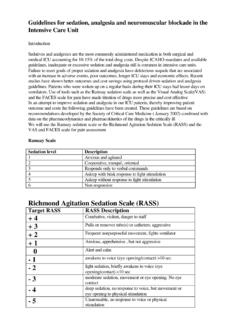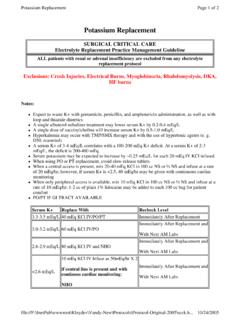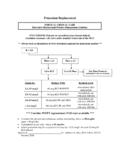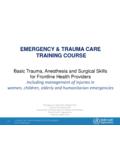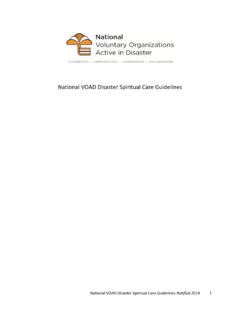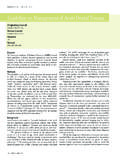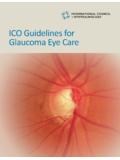Transcription of Trauma Resuscitation Guidelines
1 Vanderbilt University Medical Center Division of Trauma & Surgical Critical care Clinical Management Guideline: Standard Trauma Resuscitation Global Communication is the key to a well organized and efficient Trauma Resuscitation . Individual conversations must be kept at a minimum and in general only ONE voice should be heard by ALL Trauma Resuscitation team personnel. All information is to be communicated for every member of the team to hear. This information is directed by the Trauma team leader. Individuals with direct patient contact, or those who will have possible contact with bodily fluids, will observe Universal Precautions, instituted prior to the patient s arrival if possible.
2 This will include: Essential Optional: Gown Lead apron preferable for those at head of Head Cover bed, primary nurse and PCT Shoe Cover Gloves Eye Protection Mask Sterile gowns and gloves, head covers and mask plus sterile barriers SHOULD BE USED WHEN PERFORMING ALL STERILE PROCEDURES such as chest tube insertion, central line placement and diagnostic peritoneal lavage, ED thoracotomy or wound explorations. Trauma Resuscitation Team: Personnel 1. Trauma Team Leader (TTL) PGY4 Surgical Resident 2.
3 Trauma Attending / Fellow (TA/TF) 3. Primary MD (PMD) PGY2 Surgical Resident, PGY 1 or 2 ED resident rotating on Trauma Service 4. Primary Airway MD (PAMD) PGY 2/3 ED resident 5. ED Attending (EDA) 6. Primary Nurse (PN) 7. Secondary Nurse (SN) or Paramedic (P) 8. Scribe Nurse (Scribe) 9. Patient care Technician (PCT) 10. Respiratory Therapist (RESP) 11. Radiology Technicians (RT) 12. Trauma Nurse Practitioner (TNP) present at night, occasionally during day 13. Medical Student (MS) MS 3 or 4 14. Service Center Personnel 15. Environmental Services 16. VU Police Trauma Resuscitation Team Positioning EDA PAMD Scribe Nurse TTL TA/TF PMD PN SN or P TNP PCT Trauma Resuscitation Team Personnel: Detailed Description of Responsibilities 1.
4 Trauma Team-Leader (TTL): A Senior (PGY-4) Surgical Resident will be the team leader and directs the overall Resuscitation . He/She will be identified by a green surgical head cover. The TTL will initiate the primary survey and assume responsibility for life saving procedures such as assisting with airway management including surgical airway, emergent chest tube placement, and ED thoracotomies. The TTL may pass the responsibility of directing the Resuscitation to the Trauma fellow or Trauma Attending if personally performing such advanced procedures. The TTL is responsible for the majority of communication except during intubation when it is allocated to the PAMD & ED Attending.
5 2. Trauma Attending or Fellow (TA or TF) The Trauma Attending or Fellow will be overall responsible for the Resuscitation and supervising the Trauma Team Leader. If the Trauma Attending or Fellow is not present, the ED Attending will assume this role and responsibility. TA/TF is the designated Trauma triage officer directing flow of patients to the OR, CT and ICU. TA/TF must be in close communication with the Trauma Charge Nurse for bed allocation and bed availability. 3. Primary MD (PMD) A Second Year Surgical or Emergency Department Resident rotating on the Trauma service will perform their portion of the primary survey (BCD) assisted as necessary by the Trauma team leader.
6 This MD will then perform the secondary survey from the neck down, which will include assuring that two large bore IV s are in place and functioning, blood has been obtained for T&S or C and labs, and that the placement of nasogastric tubes has been carried out. The TTL may also assign the PMD to perform invasive procedures such as central line placement, chest tube insertions, wound explorations and assisting with ED thoracotomies. 4. Primary Airway MD (PAMD) - A 2nd or 3rd year ED resident will be responsible for assessing the adequacy of the Trauma patient s airway and in concurrence with the EDA and TTL determine the need for intubation (if not already performed by pre-hospital personnel).
7 If the patient is awake and conscious, the PAMD should briefly inquire about allergies, pre-existing medical problems and medications. If intubation is necessary the PAMD & or EDA confirms and communicates to the PN, RSI medication doses. Once intubated and PAMD confirms and globally communicates ETT color change, saturations, ETT size and position. The PAMD is also responsible for C-spine stabilization, head examination of the secondary survey including pupillary and verbal response of a neurologic examination, control of bleeding from scalp lacerations and insertion of either an NG or OG. 5. ED Attending (EDA) Will be responsible for the airway and supervising the PAMD.
8 In the absence of the TA or TF, the EDA will be overall responsible for the Resuscitation and supervising the TTL. The EDA is also responsible for all ED staffing, equipment and triage into the ED. The EDA may also assume the role of TTL during the Resuscitation of multiple patients. 6. Primary Nurse(PN)- This is a nurse who will give direct patient care by helping perform the primary assessment, including assisting with airway management if necessary or starting O2 with a high flow mask. Monitoring devices such as EKG s and O2 sat monitors should be promptly placed, and the blood pressure should be frequently monitored. The PN will then assure that 2 large bore IV s are in place and functioning, or will place such IV s (14 or 18 gauge).
9 The PN will assist as needed with the secondary assessment, NG or log-rolling the patient and then prepare the patient to leave the Resuscitation room by making available O2 or ventilators, securing all IV bags and by preparing appropriate monitoring for transport. The PN is also responsible for administering any medications for rapid sequence intubation, antibiotics, steroids or medications for pain and analgesia. 7. Secondary Nurse (SN) The SN or P will assist the PN with all of the above Or Paramedic (P) mentioned duties. The SN or P will obtain the first from the left arm and call out the reading for everyone to hear. This person is also responsible for transporting the patient to CT, or TICU and having the Gold Key available for the elevator leading directly to the 8.
10 Scribe Nurse (Scribe) This nurse is primarily responsible for keeping records, assuring that all standard tests or other labs as ordered by MD, are completed. (Blood sent to the blood-bank for T and S or C, blood & urine for lab testing, CT scans ordered, Trauma gram ordered, etc.) This nurse will also assist in direct patient care in times of hemodynamic instability or managing multiple simultaneous Trauma admissions. The Scribe Nurse will also assist with preparation for transport from the Resuscitation room if all their primary responsibilities are complete. The Scribe Nurse is also responsible for noise control and ensuring only those personnel directly involved in patient care are in the Trauma bay.
